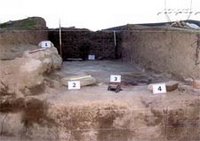Asheulian Stone Tools, New Mystery of Kaluraz

Tehran, 1 February 2006 (CHN) -- Discovery of man-made stone tools in Parthian layers of Kaluraz Tepe in Gilan province which are similar to those of the Asheulian epoch have raised new questions about the age of this historical site. Prior to this, the existence of Asheulian culture had already been discovered near this historical site at Ganj-Par.
“Some stone tools similar to those which had already been found in the basin of Sefidrud River belonging to the Asheulian culture (some 700,000 years ago), have been discovered in the Parthian layer of Kaluraz Tepe. Discovery of this stone tool in the layers belonging to the Parthian era indicates that most probably a mistake has been made in dating these objects,” said Mohammad Reza Khalatbari.
Previous studies on the upper layers of Sefidrud River resulted in the discovery of a collection of man-made stone tools belonging to the Asheulian culture, which were a proof of existence of human beings in this region.
“The question is that if these artifacts belong to the Paleolithic era, why have they been found in the upper layers of the ground? Most often such artifacts are expected to be discovered in caves or among the layers of sediments,” explained Khalatbari.
According to Khalatbari, such stone tools are still being used in regions such as Roudbar to crush olive then it can be concluded that these tools were used by human beings in their everyday life.
In any case, Paleontology experts believe that the newly discovered stone tool in Kaluraz is most probably a whetstone, formed by abrasion, while the stones dating back to the Paleolithic era were carved stones. Besides, according to geological studies, the upper layers of the basin of a river, called terrace, are older than the lower layers since the water stream gradually washes away the river basins and move the rocks and sediments down the river.
Experts on the Paleolithic era, such as Professor Jack Joubert, who examined the collection of stone tools discovered near Sefidrud River and Ganjpar area in Rostam Abad, have confirmed that they must have belonged to the Asheulian culture. A report about the discovery of this collection was published in the “Antiquity Journal” and a seminar has also been held in the United States in Pennsylvania in this respect. Both Iranian and foreign experts have confirmed that stone tools of the Ganjpar region and the surrounding areas of Sefidrud River must have belonged to the Asheulian culture.
The similarity of the discovered objects in Sefidrud River and Kaluraz historical hill must be studied by experts to reveal the exact date of Kaluraz Tepe in Gilan province.
Asheulian culture is an ancient one dating back to some one and half million to 250 thousand years ago. It was formed in east of Africa and then was spread to Palestine, Syria, Lebanon, Saudi Arabia, Caucasian region, Armenia, Georgia, and the Indian Peninsula with the migration of Asheulian people.

1 Comments:
Hi nicce reading your blog
Post a Comment
<< Home